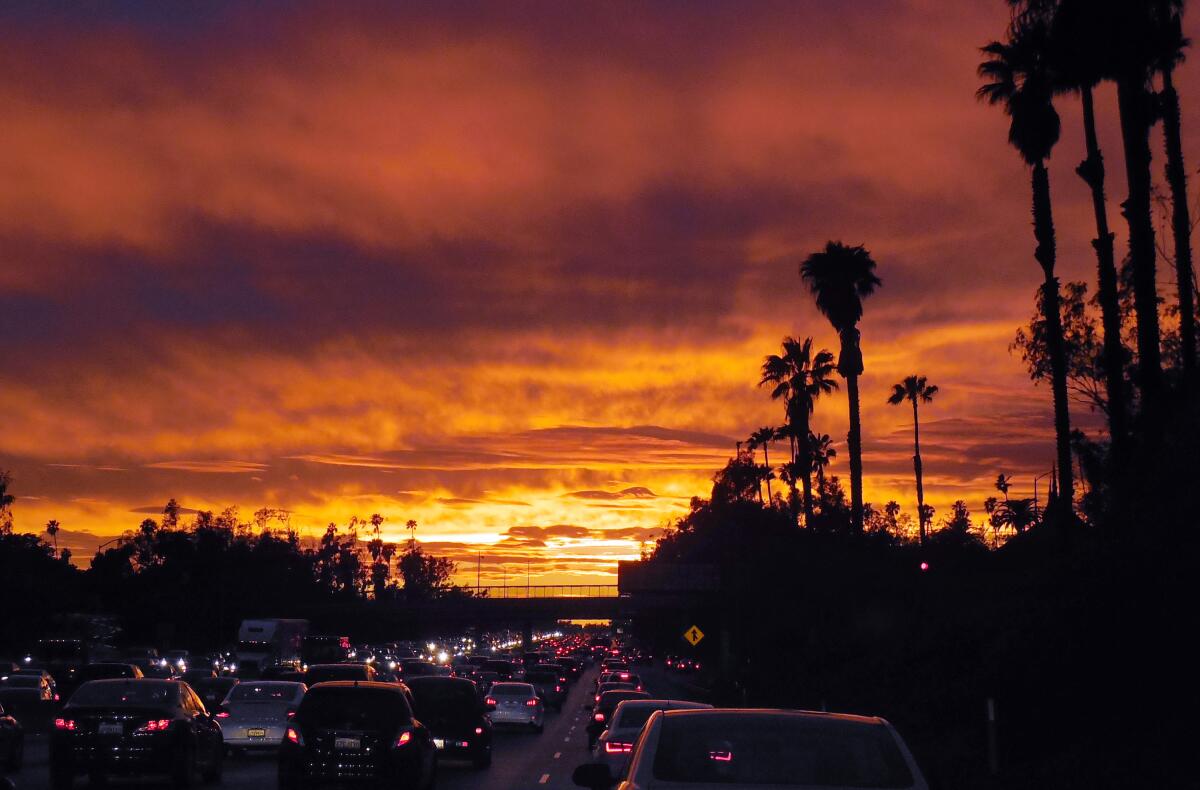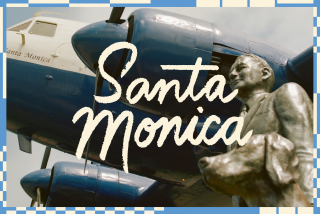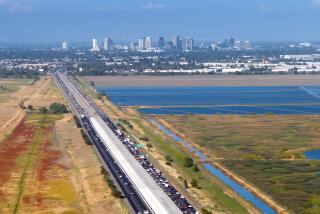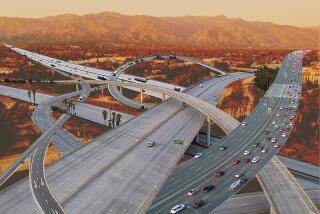Op-Ed: The common thread between L.A.’s 1976 carpool fiasco and anti-vax protests

- Share via
For most of the year, our screens have been filled with stories and images of protesters railing against a mandate. It is unconstitutional, they say. Un-American. An infringement on our inalienable rights.
But the year is not 2021, and the issue is not mandatory COVID-19 vaccinations. It is 1976, and Angelenos are up in arms over a Caltrans decision to convert the left-most lanes (in both directions) of the Santa Monica Freeway (I-10) into high-occupancy vehicle (HOV) lanes between downtown Los Angeles and Santa Monica. These lanes were painted with giant white diamonds to mark their status.
To comply with stricter emissions standards established by the Clean Air Act of 1970, California’s Department of Transportation began to reimagine the freeways and came up with the idea of the diamond lane. On weekdays, during morning and evening rush hours, the lanes would be reserved for cars with three or more passengers or for buses. It took till 1976 for the plan to be carried out along this 12-mile stretch of the 10 Freeway.
On the morning of March 15 commuters fumed when the Santa Monica Freeway’s general-purpose lanes were suddenly turned into a parking lot, with the new diamond lanes largely empty.
The resulting bedlam brought out many of the same reactions we encounter among anti-vaxxers. Demonstrators marched along freeway shoulders and overpasses when they weren’t picketing Gov. Jerry Brown’s L.A. presidential campaign headquarters.
I was a 10-year-old in West L.A. at the time. Watching the nightly 6 p.m. news with my parents, the diamond lane debacle was ready-made television. It was my first time hearing the term “socialism” — in this case, a reference to the government forcing people out of their cars and into other people’s vehicles. Instead of “My Body, My Choice,” it was a period of “My Car, My Choice.”
Just as people are fighting vaccine mandates via lawsuit today, in 1976 some objectors to the diamond lane took their cases to court. Motorist Eric Julber was the first citizen to file suit against the state. His case argued two points, the first being that the state had failed to file an environmental impact statement on the project. His second argument: Caltrans’ three-person-per-car minimum mandate was discriminatory — against drivers of two-seat cars. (Only in Los Angeles could owners of Porsches and Corvettes be seen as victims.) When that tactic didn’t work, Julber asserted that the new law violated the “rights of the people” invoked by the 9th Amendment — an argument often cited in anti-vaccination circles today.
Aside from the drama, the protesters had a legitimate beef. The California Highway Patrol stated that 97% of vehicles on L.A. freeways held only one or two occupants. By taking away one of four lanes, Caltrans removed 25% of usable real estate for motorists without offering much in the way of viable alternatives for solo drivers. Ironically, the additional traffic caused by the loss of the lane may have added to the pollution the state was trying to alleviate.
As the weather heated up, so did people’s tempers. Saboteurs dumped tacks on the diamond lane and blotted out the diamond insignias with paint. Drivers smashed into other cars as a result of unsafe maneuvers while weaving in and out of the empty restricted lanes. Commentary from talk radio hosts, national news correspondents and politicians only added to the circus. Even “Tonight Show” host Johnny Carson made it the punchline of a joke as the mystic Carnac the Magnificent:
Answer: The diamond lane.
Question: What does Zsa Zsa Gabor call the center of a church?
After a rash of lawsuits and death threats to the head of Caltrans, the state ended the diamond lane experiment after a judge ruled in a suit filed by the Pacific Legal Foundation that Caltrans should have conducted an environmental review. The HOV lanes reverted to general lanes on Aug. 13, 1976.
To this day, the Santa Monica Freeway is one of the few L.A. freeways without rideshare lanes, as widening it to add them could cost well over $1 billion. HOV lanes established in California after the 1976 debacle have involved the addition of new lanes, rather than the conversion of regular lanes into carpool lanes, a key reason for the failure of the initial attempt.
Surveying today’s furor over vaccine mandates, the kid in me recognizes the echoes from the past. A governmental agency had asked then that people undergo a collective sacrifice only to find that individual rights — in that case, the freedom of the solo driver — almost always trump the greater good, at least during non-wartime.
Time and again Americans pay a price for refusing to look at the bigger picture. In 1976, costs included a setback to an environmentally sensitive transportation policy and a possible solution to worsening traffic. In 2021, if vaccine mandates fail, the repercussions will be far more dangerous.
The whole city, it seemed, hated her.
Paul Haddad is an author who lives in and writes about Los Angeles. His new book, “Freewaytopia: How Freeways Shaped Los Angeles,” will be published in October. @la_dorkout
More to Read
A cure for the common opinion
Get thought-provoking perspectives with our weekly newsletter.
You may occasionally receive promotional content from the Los Angeles Times.










